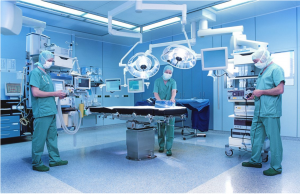BY ANOKHI SAKLECHA | SQ STAFF WRITER | SQ ONLINE (2015-16)
You step into the examination room and take a seat in the patient’s chair, prepared for your yearly physical exam. Minutes later, your doctor walks in, and after briefly shaking hands with you, situates himself behind his large computer monitor. He begins asking questions about your health conditions, personal life, and medical history, all while rapidly clashing his keyboard and clicking through digital files, only occasionally making eye contact with you. Rushingly, he’ll conclude the visit with a quick look at your eyes, ears, and throat using medical devices. One toothy grin and departing handshake later, he’s out the door, running to see his next patient.
Seem familiar? With the increasing technological advancements of our world, unfortunately, we have all experienced this scenario at some point in time. In today’s day and age, doctors are overwhelmingly focusing on the hard and fast facts of medicine, often forgetting that science is only half of the equation. Medicine is a perfect amalgamation of science and art, logic and intuition, knowledge and communication. However, cutting-edge medical research and high-tech devices have left bedside manner and patient connection in the dust.
Medicinal knowledge and skill are obvious indicators of clinical proficiency, but just as important are compassion and communication. A mantra that I’ve often heard is “treat the patient, not the disease.” In other words, physicians and medical caretakers should strive to not only diagnose illnesses and alleviate symptoms but also listen to patients’ stories, mitigate their concerns, and comfort their families. Sure, medical technologies may allow physicians to more accurately and efficiently diagnose and treat patients; but, this does not mean that they need to lose the human-to-human connection of medicine.

Once upon a time, physical exams were much more common in the medical field – ones where doctors actually touched a patient rather than solely performing a sequence of high-tech diagnostic tests. This human touch was known to instill a level of confidence within the patient – a human-to-human connection that reassured and relieved them. As physician-author Abraham Verghese puts it, the most important innovation in medical history is “the power of the human hand.”
In fact, it has been scientifically proven that human connection and empathy can improve a patient’s medical experiences. A study published in the Journal of Hand Surgery states that empathy contributes to over 65% of patient satisfaction. And, while this may all seem straightforward in writing, it becomes rather ambiguous in practice. Where do physicians draw the line in balancing science and empathy? What should be prioritized?
While there are no correct answers to these questions, it is important that these issues be introduced early in a pre-medical student’s education. Throughout an aspiring physician’s undergraduate and medical school career, they should be taught not only the mechanisms of bodily disease but also how to approach professional care with compassion, clear communication, and “the human touch.” This method of teaching could make empathy a more natural trait in training physicians, resulting in a more trusting, personal, and resilient medical world.
[hr gap=”0″]
Sources:
- http://hitconsultant.net/2016/03/02/65-of-patient-satisfaction-attributed-to-physician-empathy/
- http://journalofethics.ama-assn.org/2007/06/medu1-0706.html
